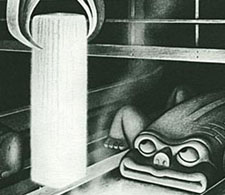Gary Genosko is Professor of Communication and Digital Media Studies at University of Ontario Institute of Technologyin Toronto. He is the author and editor of over 20 volumes, the most recent of which are, as author, When Technocultures Collide: Innovation from Below and the Struggle for Autonomy (Wilfrid Laurier University Press, 2013) and Remodelling Communication: From WWII to the WWW (University of Toronto Press, 2012). His next book, Critical Semiotics: From Information to Affect, is in press with Bloomsbury.

Authors | Gary Genosko
Articles on Amodern by Gary Genosko
AMODERN 5: HARLEY PARKER
Harley Parker was born in Thunder Bay (then Fort William), Canada in 1915 and spent his youth there, graduating from high school and then in a compressed one-year degree from a local technical institute. He studied at Ontario College of Art (OCA), where he excelled, graduating in 1939, and between 1940-42 he took up posts at Cooper and Beatty and T. Eaton and Co. in Toronto as a typographic designer. His typographic skills and experimental style would prove to be dazzling, to which two of his later collaborations with Marshall McLuhan would attest, first in the guise of Explorations 8 (Verbi-Voco-Visual Explorations) (1957), and later in the book Counterblast (1969). After serving in the Canadian military from 1942-45 where he was Sergeant Instructor to the Camouflage Wing, he returned to take up a teaching post at OCA where he remained until 1957 when he joined the Royal Ontario Museum (ROM). During his second year back at OCA he pursued a post-graduate course at the Summer Arts Institute of Black Mountain College in Asheville, North Carolina. That year (1946) Bauhaus professor Josef Albers taught color theory and Parker took his class. Parker’s career as Head of Exhibit Design at the ROM lasted until June 30th, 1968, after completing most of a year-long leave of absence. The ROM’s employee card put the matter dryly: “Did not return.” During his leave Parker accompanied McLuhan to Fordham University where he took the post of Associate Professor in the Albert Schweitzer Program, during McLuhan’s year there as a research chair. Parker would later occupy the first William A. Kern Chair in Communications at the Rochester Institute of Technology (1973).
The story of Parker’s career is not well known, despite his much publicized collaborations with McLuhan in books (co-authoring Through the Vanishing Point, 1968), films (Picnic in Space, 1967), and events like the seminar on Museum Communication at the Museum of the City of New York (1967). This special issue of Amodern – the second of my Parker-focused activities following upon the 2012 seminar in Oshawa, Harley Parker and Challenge to Curatorial Authority, during which several of the papers published here were first presented – will contribute to filling in the gaps and consolidating Parker’s considerable accomplishments. Parker remains an enigma in part due to his status, first, as a problem-solving installation designer within a university museum that valued curation over design, and second, as a celebrated designer operating in the shadow of a major public intellectual, McLuhan; at worst, this position can be summed up by those newspapers wags who simply said he was “fronting” for McLuhan. The essays in this special issue reveal that Parker authored numerous articles on design and perception, and appeared regularly in the Toronto newspapers as a jack-of-all-trades prepared to speak on art, society, technology, and architecture.
WHERE THE YOUTH AREN’T
Harley Parker’s Struggles at the Royal Ontario Museum
This paper examines Harley Parker’s main achievement as Head of Installation at the Royal Ontario Museum, the “Hall of Fossils” that opened in January 1967; it was dismantled decades later. Parker’s explanations of the decisions he made in constructing the exhibits, as well as deviations from the subject matter proper of paleontology, are considered within an overall critical assessment of the challenge he faced in reaching a very specific audience. His meditations on why it was important to reach a youth and “hippy” countercultural viewership are contextualized in relation to the theories of his colleague and collaborator Marshall McLuhan, and his failures in this regard are exposed and discussed.
THE “UNKNOWN” EXPLORATIONS
This paper focuses on the famous journal Explorations, co-edited by Marshall McLuhan and Edmund Carpenter in the 1950s with, however, an important exception. After the initial 9 issues, the journal was reborn as an insert in the University of Toronto alumni and public relations department's journal Varsity Graduate in 1964 and boasted a run of another 8 years. This article examines this period of Explorations, the other supplements that were published alongside it, the relationships between the editors and the institutional constraints within the University of Toronto, and theorizes about the significance of this serial for the vicissitudes of scholarly publishing today.






